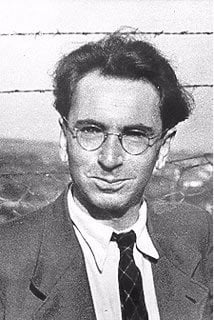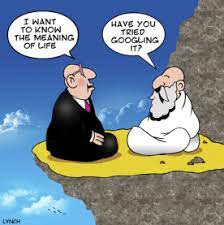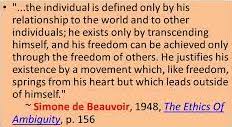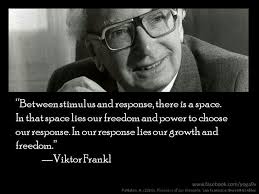by Marie Snyder
 The second half of Frankl’s Man’s Search for Meaning was added in 1962 to provide greater detail of Logotherapy, in which patients must hear difficult things in contrast to psychoanalysts provoking telling difficult things. It’s less introspective and more focused on our place in the world:
The second half of Frankl’s Man’s Search for Meaning was added in 1962 to provide greater detail of Logotherapy, in which patients must hear difficult things in contrast to psychoanalysts provoking telling difficult things. It’s less introspective and more focused on our place in the world:
“Logotherapy defocuses all the vicious-circle formations and feedback mechanisms which play such a great role in the development of neuroses. Thus the typical self-centeredness of the neurotic is broken up instead of being continually fostered and reinforced . . . the patient is actually confronted with and reoriented toward the meaning of his life. . . . Striving to find a meaning in one’s life is the primary motivational force in man. That is why I speak of a will to meaning in contrast to the pleasure principle on which Freudian psychoanalysis is centered, as well as in contrast to the will to power on which Adlerian psychology, using the term ‘striving for superiority,’ is focused” (98).
Aside: A bit of history of philosophy here: Schopenhauer wrote about the will-to-live in World as Will and Representation in 1818: our very being is our will, our blind urges towards life, and it’s also the dynamic essence of the world. He was influenced by the Buddhist Four Noble Truths in this respect, although he focused less on the practice of decreasing striving in order to reduce the experience of suffering. He preferred to soothe his misery with art.
Then Nietzsche went further with it in 1883, coining the phrase will-to-power in Thus Spake Zarathustra, and discussing the idea in many of his books, arguing that this irrational force within us can be directed toward specific ends through power over others by endearing them to us or, less preferred, through intimidation. Power is a means to an end to find truth or create or become rich or develop self-mastery, etc. It’s just our nature to do this, so we can’t judge it, but he favours sublimation of the will to power into creative acts. Then in 1929, in Civilization and its Discontents, Freud also praised sublimation as a mature defence mechanism in which we overcome suffering through mental escape as we immerse ourselves in a useful or creative task. Freud didn’t think escaping our troubles was a problem in itself provided it was done in the right manner: our pleasure principle needs to be guided by our reality principle; being productive is better than being entertained. The existentialist movement had more concerns with the lack of authenticity that comes from escaping reality.
And way before all those guys, 2500 years ago, Heraclitus coined the term Logos as the unity of all things. He’s the guy who said we can’t step into the same river twice because everything is in constant flux. Then the Stoics wrote about Logos as a force or energy that is bound in all living things, as opposed to matter. It’s the anima mundi – a world soul. Made of pneuma/breath blended throughout everything, Logos is the rational principle that orders the universe. Plants have it to make them grow and throw seeds into the wind, and people have it to give them the passion and reason to live virtuous lives. Then it made an appearance in the Bible in John 1:1: “In the beginning was the Word, and the Word was with God, and the Word was God.” Logos was translated to word as in reason or discourse or plan. The Stoics didn’t believe in a God that affects our lives, but they did think there’s some natural organization of things, and that we’re all much happier, and much more just, if we align ourselves with this, which IS virtue.
Back to Frankl: His effort to reoriented towards the meaning of his life fits with the Stoic used of the term “Logos” as intimately tied to virtues, and it’s reminiscent of Schopenhauer’s sense of the will-to-life that is necessary for us to keep going, but it’s also very existential, bringing to mind Sartre’s Being and Nothingness, which came out in 1943, when Frankl says,
“This meaning is unique and specific in that it must and can be fulfilled by him alone; only then does it achieve a significance which will satisfy his own will to meaning. . . . I would not be willing to live merely for the sake of my ‘defense mechanisms,’ nor would I be ready to die merely for the sake of my ‘reaction formations.’ Man, however is able to live and even to die for the sake of his ideal and values” (99).
He explains the existential frustration that happens when people can’t reach their meaning, which can result in a type of neuroses he calls “noögenic neuroses,” as opposed to the typical psychogenic neuroses. Getting past noögenic neuroses requires help until we’re “unable to see the forest of reality for the trees of symbols and images” (102).
“Existential frustration is in itself neither pathological nor pathogenic. A man’s concern, even his despair, over the worthwhileness of life is an existential distress but by no means a mental disease. . . . It is his [therapist’s] task to pilot the patient through his existential crises of growth and development. . . . In logotherapy’s attempt to make something conscious again it does not restrict its activity to instinctual facts within the individual’s unconscious but also cares for existential realities, such as the potential meaning of his existence to be fulfilled as well as his will to meaning. . . . Man’s search for meaning may arouse inner tension rather than inner equilibrium. However, precisely such tension is an indispensable prerequisite of mental health. . . . In the Nazi concentration camps, one could have witnessed that those who knew that there was a task waiting for them to fulfill were most apt to survive” (102-4).
I love this acknowledgement of the benefit of having an authentic relationship with the self and the world despite it causing stress and tension. Many institutions have moved to an untenable position on mental health that suggests we should never feel stress, which can instead leave people in a state of ennui and buried distress. It’s also similar to the positive psychologists, like Martin Seligman‘s ideas that if we perceive control over a situation, it becomes a reality, which goes back to William James, and, again, to the Stoics. Frankl contrasts Freud’s depth psychology, delving into the past, to logotherapy’s “height psychology,” which focuses on the person’s future. But it’s deeper and less intentional (or forced) in the way some positive psychology can be.
This tension between what one is and what one should become is inherent and indispensable to well-being.
“We should not, then, be hesitant about challenging man with a potential meaning for him to fulfill. It is only thus that we evoke his will to meaning from its state of latency. I consider it a dangerous misconception of mental hygiene to assume that what man needs in the first place is equilibrium. . . . What man needs is not homeostasis but what I call “noö-dynamics,” i.e., the existential dynamics in a polar field of tension where one pole is represented by a meaning that is to be fulfilled and the other pole by the man who has to fulfill it” (105).
He then turns to patients who feel an existential vacuum within, who have no sense of what’s important in life, no instincts, no tradition, no desires, so they blindly follow the crowd or the leader. It typically manifests in boredom, which can become depression, aggression, addiction, or suicide. Sometimes it’s compensated for by a will to power, seeking out money beyond all requirement, or a will to pleasure seen in an obsession with sex. To Frankl, these are both symptoms of an internal vacuum.
 What is the meaning of life? It differs for each person and within people at each stage of life. He explains,
What is the meaning of life? It differs for each person and within people at each stage of life. He explains,
“To put the question in general terms would be comparable to the question posed to a chess champion: ‘Tell me, Master, what is the best move in the world?’ There simply is no such thing as the best or even a good move apart from a particular situation in a game. . . . Everyone has his own specific vocation or mission in life to carry out a concrete assignment which demands fulfillment. Therein he cannot be replaced, nor can his life be repeated. Thus, everyone’s task is as unique as is his specific opportunity to implement it. . . . Each man is questioned by life; and he can only answer to life by answering for his own life; to life he can only respond by being responsible. Thus logotherapy sees in responsibleness the very essence of human existence” (108-9).
Therapists shouldn’t impose any value judgments on clients not just because it can be steeped in cultural stereotypes, but because it takes the onus off the client to determine their own value system.
“To put it figuratively, the role played by a logotherapist is that of an eye specialist rather than that of a painter. A painter tries to convey to us a picture of the world as he sees it; an ophthalmologist tries to enable us to see the world as it really is. . . . The true meaning of life is to be discovered in the world rather than within man or his own psyche, as though it were a closed system. . . . Being human always points, and is directed, to something, or someone, other than oneself–be it a meaning to fulfill or another human being to encounter. The more one forgets himself–by giving himself to a cause to serve or another person to love–the more human he is and the more he actualizes himself. . . . Self-actualization is possible only as a side-effect of self-transcendence” (110-11).
This harkens back to the Stoic idea of Logos and the idea of a universal order or energy as well as Sartre’s phenomenology. We can’t ever think of ourselves as contained beings separate from all that exists in the world. This perception of psychodynamic theory is in fact the very opposite of the navel gazing it’s sometimes portrayed as!
We can discover meaning in three ways: 1. by creating (art, work, action), 2. by experiencing something (truth, beauty, love, etc.) through encountering something outside ourselves, and 3. by the attitude we take toward unavoidable suffering. “To achieve personal meaning, one must transcend subjective pleasures by doing something that points, and is directed, to something, or someone, other than oneself by giving himself a cause to serve or another person to love.” (159). Love, or caring, in particular helps people to see their own potential that is not yet actualized through their connection with and understanding of another. Suffering helps us find meaning through recognizing human potential at its best as it transforms tragedy into triumph, and, when we can’t change a situation, in our challenge to change ourselves,
“Suffering ceases to be suffering at the moment it finds a meaning, such as the meaning of a sacrifice. . . . It is one of the basic tenets of logotherapy that man’s main concern is not to gain pleasure or to avoid pain but rather to see a meaning in his life. . . . In no way is suffering necessary to find meaning. I only insist that meaning is possible even in spite of suffering–provided, certainly, that the suffering is unavoidable. . . . To suffer unnecessarily is masochistic rather than heroic” (113).
Many people going to therapy, he pointed out in the 60s, aren’t neurotic, and might be better served by a pastor, but that’s gone out of favour. Therapists are the new clergy.
“At any moment, man must decide, for better or for worse, what will be the monument of his existence. Usually, to be sure, man considers only the stubble field of transitoriness and overlooks the full granaries of the past, wherein he salvaged once and for all his deeds, his joys and also his sufferings. Nothing can be undone, and nothing can be done away with. I should say having been is the surest kind of being. . . . Instead of possibilities, I have realities in my past, not only the reality of work done and of love loved, but of sufferings, bravely suffered” (121-2).
As a technique with clients, he starts with any anticipatory anxiety to trace back to deeper fears as well as any excessive intentions or attention towards achievement of a goal. “Pleasure is, and must remain, a side-effect or by-product, and is destroyed and spoiled to the degree to which it is made a goal in itself” (122), so excessive ideation must be “dereflected.” He condemns future fears and also what has become currently popular: the manifestation of things. “Hyper-intention makes impossible what one wishes” (123). Instead his procedure is a reversal of the client’s attitude — replace fears with wishes to take the wind out of its sail, not unlike Stoic negative meditations, and applying paradoxical intentions in order to detach from the outcomes and learn to laugh at himself. Fighting against ideas that haunt us increases their power to disturb us. “The cue to cure is self-transcendence!” (129); we have to get outside of ourselves to be virtuous, to forget the self by giving of the self, which has a byproduct of reducing depression. Then he gets into something we really need to hear these days:
“Freedom is only part of the story and half of the truth. Freedom is but the negative aspect of the whole phenomenon whose positive aspect is responsibleness. In fact, freedom is in danger of degenerating into mere arbitrariness unless it is lived in terms of responsibleness. That is why I recommend that the Statue of Liberty on the East Coast be supplemented by a Statue of Responsibility on the West Coast. . . . A human being is not one thing among others; things determine each others, but man is ultimately self-determining. What he becomes–within the limits of endowment and environment–he has made out of himself. . . . Some of our comrades behave like swine while others behaved like saints. Man has both potentialities within himself, which one is actualized depends on decisions but not on conditions” (132-4).

Finally, in a lecture presented in 1983, he calls for “tragic optimism,” that is, remaining optimistic despite pain, guilt, and death by,
“(1) turning suffering into a human achievement and accomplishment; (2) deriving from guilt the opportunity to change oneself for the better; and (3) deriving from life’s transitoriness an incentive to take responsible action” (138).
In contrast to Freudian psychoanalysis, Frankl acknowledges that feelings of guilt cannot be fully traced back to original factors; only machines can be fully explained. Instead, we are “responsible for overcoming guilt by rising above it, by growing beyond yourselves, by changing for the better” (149). The reality of death “challenges us to make the best possible use of each moment of our lives” (150).
Finding meaning in suffering means that meaning is potentially unconditional paralleled by the “unconditional value of each and every person,” which is “based on the values that he or she has realized in the past and is not contingent on the usefulness that he or she may or may not retain in the present” (151). Conditional value, predicated on usefulness, adores people who are successful, exuberant, and/or young. Unconditional value is predicated on the very existence of each individual, affording dignity to each.
He concludes with a discussion of decent people:
“It is true that they form a minority. More than that, they always will remain a minority. And yet I see therein the very challenge to join the minority. For the world is in a bad state, but everything will become still worse unless each of us does his best. So, let us be alert–alert in a twofold sense: Since Auschwitz we know what man is capable of. And since Hiroshima we know what is at stake” (154).
“The world is in a bad state, but everything will become still worse unless each of us does his best” (164).

